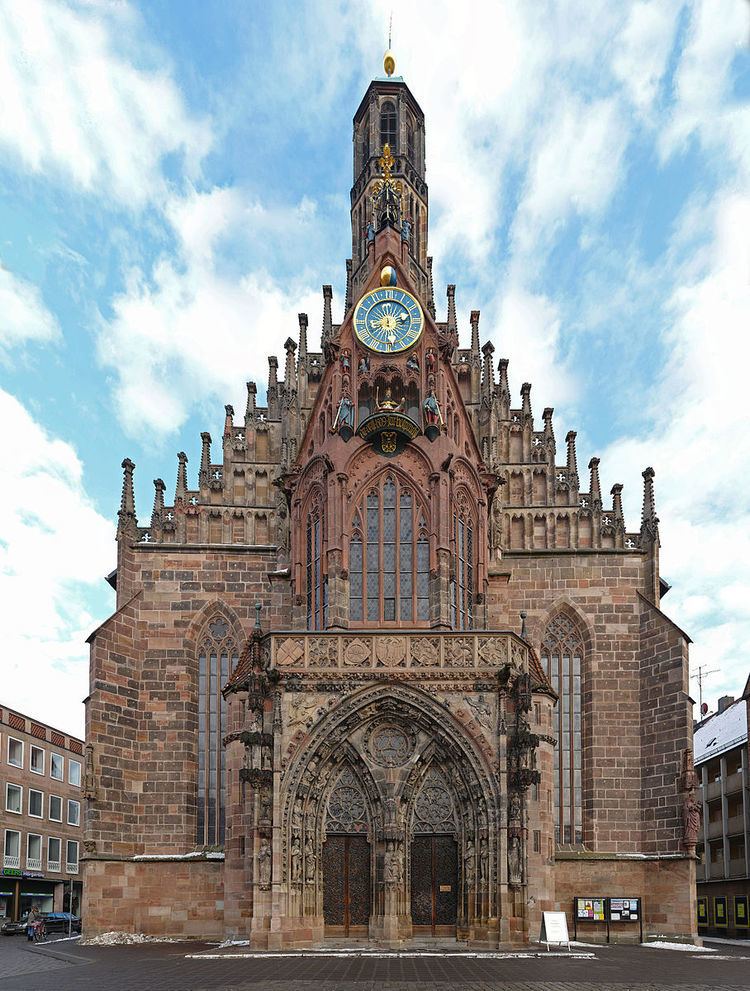Denomination Roman Catholic Opened 1361 | Consecrated 1358 Functional status Active Capacity 25,000 Phone +49 911 206560 | |
 | ||
Similar St Lorenz - Nuremberg, Hauptmarkt, Albrecht Dürer's House, Nuremberg Castle, St Sebaldus Church | ||
Organist in frauenkirche nuremberg 10 1 2016
The Frauenkirche ("Church of Our Lady") is a church in Nuremberg, Germany. It stands on the eastern side of the main market. An example of brick Gothic architecture, it was built on the initiative of Charles IV, Holy Roman Emperor between 1352 and 1362. The church contains many sculptures, some of them heavily restored. Numerous works of art from the Middle Ages are kept in the church, such as the so-called Tucher Altar (c. 1440, originally the high altar of the Augustinian church of St. Vitus), and two monuments by Adam Kraft (c. 1498).
Contents
- Organist in frauenkirche nuremberg 10 1 2016
- History
- Architecture
- Mnnleinlaufen
- Organ
- Modern history
- References
History
The church was built in the grand market, in place of the former Jewish synagogue, which was destroyed during the pogrom of 1349 (which followed an outbreak of Black Death). The architect was probably Peter Parler. Charles IV wanted to use the Frauenkirche for imperial ceremonies, which is reflected in the porch with the balcony, and in the fact that the church is relatively unadorned except for the coats of arms of the Holy Roman Empire, the seven Electors, the town of Nuremberg, and the city of Rome, where the Holy Roman Emperors were crowned.
Charles IV's son Wenceslas was baptized in the church in 1361, on which occasion the Imperial Regalia, including the imperial reliquaries, were displayed to the people. Beginning in 1423, the Imperial Regalia was kept permanently in Nuremberg and displayed to the people once a year on a special wooden platform constructed for that purpose.
Architecture
The Frauenkirche is a hall church with two aisles and a tribune for the emperor. The church contains nine bays supported by four columns.
The triforium, named the Imperial Loft or St. Michael's Loft, opens on to the nave by means of an arcade, the arches of which are filled with floating tracery, consisting of three rosettes supported by a segmental arch.
The narthex of the church contains tracery. All three sides of the narthex have portals, the jambs and archivolts of which are decorated with sculptures. The gable contains many niches, which used to house sculptures.
Männleinlaufen
One of the most notable features of the church is the Männleinlaufen, a mechanical clock that commemorates the Golden Bull of 1356. The clock was installed in the church in 1506. The Holy Roman Emperor is shown seated with the prince-electors surrounding him.
The clock mechanism is activated at midday, when a bell is rung to start the sequence and is followed by the trumpeters and drummer. Then there is a procession of the electors around the figure of the Holy Roman Emperor.
Organ
The earliest reference of a church organ dates from 1442. The current organ was built in 1988 by Klais Orgelbau of Bonn, re-using 20 ranks from the previous instrument.
Modern history
In Triumph of the Will, Leni Riefenstahl's 1935 propaganda film about the 1934 Nuremberg Rally, the final scene consists of a military parade through downtown Nuremberg, with Adolf Hitler shown receiving salutes from Nazi troops with the Frauenkirche in the background.
Since 1948, the balcony of the church, below the Männleinlaufen, is used for the opening ceremony of the Christkindlesmarkt.
The church parish and the neighboring Parish of St. Elizabeth are known collectively as the "Katholische Innenstadtkirche Nürnberg" (Catholic Downtown churches of Nuremberg).
